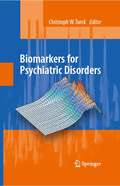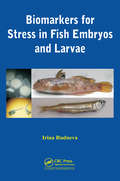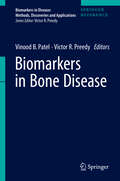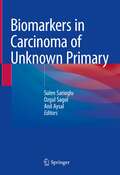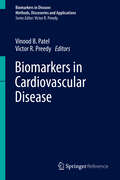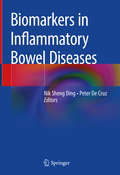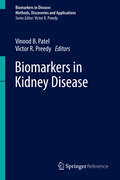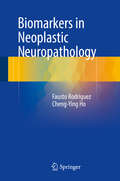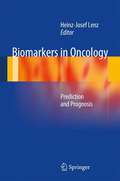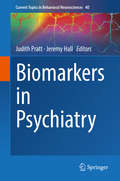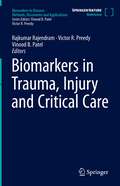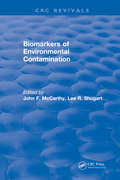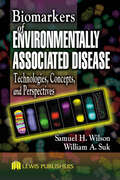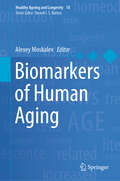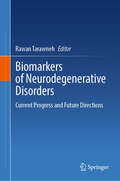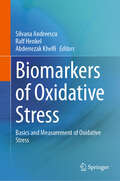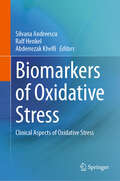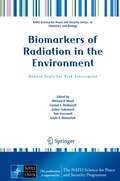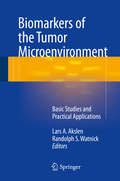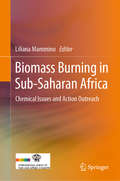- Table View
- List View
Biomarkers for Psychiatric Disorders
by Chris TurckBiomarkers hold immense promise for the early detection of disease. Unlike other disorders like diabetes and heart disease where a limited number of biological markers are at hand that allow the physician to come up with a reliable diagnosis, there are currently no such markers available for affective disorders. As in any other disease area a major goal is therefore the identification of early markers that can categorize subsets of subjects in a consistent manner. This will allow a more precise definition and categorization of affective disorders and in turn facilitate investigations of the pathogenesis of the diseases and enhance our ability for treatment. This edited volume will not only address the area of affective disorders but also other brain disorders that are neurological in nature, including Multiple Sclerosis and Alzheimer Disease.
Biomarkers for Stress in Fish Embryos and Larvae
by Irina RudnevaThe present work evaluates the toxic effects of some environmental stressors on fish eggs and larvae and describes the biomarker responses of fish from locations with varying levels of pollution. Development of the main groups of biomarkers is discussed. The book demonstrates general trends and specific peculiarities of biomarker induction in early
Biomarkers in Bone Disease (Biomarkers in Disease: Methods, Discoveries and Applications)
by Victor R. Preedy Vinood B. PatelThere are many conditions that affect the skeletal system. On a worldwide basis, osteoarthritis alone affects 10%-15 percent of those over 60 years of age and in some countries more than 30-50% of postmenopausal women will have osteopenia or osteoporosis. With the increasing ageing population, maintaining skeletal health is particularly important. Fractures in the aged, for example, can lead to premature deaths. It is therefore imperative that appropriate use is made of conventional, new and emerging biomarker platforms. Biomarkers in Bone Disease embraces a holistic approach by combining information on different conditions that affect the skeletal system and the use of biomarkers. Biomarkers are described in terms of conventional, new and emerging analytes, techniques, platforms and applications. It covers the latest knowledge, trends and innovations. New platforms are described which combine advances in biomedical sciences, physics, computing and chemistry.
Biomarkers in Carcinoma of Unknown Primary
by Sulen Sarioglu Ozgul Sagol Anil AysalThis book aims to examine all immunohistochemical and molecular pathological biomarkers that can be useful and effective in patient diagnosis, prognosis and treatment decision, especially when faced with a carcinoma of unknown primary. For this purpose, epithelial malignancies of all systems and related biomarkers are examined one by one, and to look at the subject through the metastatic regions window, biomarkers that can be used to determine the primary focus for carcinomas seen in the areas most frequently metastasized are emphasized. With this bi-directional perspective, the reader is able to find biomarkers of any type of carcinoma on a system basis, as well as access to which biomarkers can be used when faced with a metastatic carcinoma. The importance of biomarkers in patient follow-up and treatment is also conveyed through the clinician's eye, and so biomarkers are handled with a holistic approach in all aspects. This book primarily targets pathologists, as well as clinicians (oncologists and surgeons) who manage cancer patients.
Biomarkers in Cardiovascular Disease (Biomarkers in Disease: Methods, Discoveries and Applications)
by Victor R. Preedy Vinood B. PatelIn the past decade there has been a major sea change in the way disease is diagnosed and investigated due to the advent of high throughput technologies, such as microarrays, lab on a chip, proteomics, genomics, lipomics, metabolomics etc. These advances have enabled the discovery of new and novel markers of disease relating to autoimmune disorders, cancers, endocrine diseases, genetic disorders, sensory damage, intestinal diseases etc. In many instances these developments have gone hand in hand with the discovery of biomarkers elucidated via traditional or conventional methods, such as histopathology or clinical biochemistry. Together with microprocessor-based data analysis, advanced statistics and bioinformatics these markers have been used to identify individuals with active disease or pathology as well as those who are refractory or have distinguishing pathologies. New analytical methods that have been used to identify markers of disease and is suggested that there may be as many as 40 different platforms. Unfortunately techniques and methods have not been readily transferable to other disease states and sometimes diagnosis still relies on single analytes rather than a cohort of markers. There is thus a demand for a comprehensive and focused evidenced-based text and scientific literature that addresses these issues. Hence the formulation of Biomarkers in Disease. The series covers a wide number of areas including for example, nutrition, cancer, endocrinology, cardiology, addictions, immunology, birth defects, genetics, and so on. The chapters are written by national or international experts and specialists.
Biomarkers in Drug Discovery and Development: A Handbook of Practice, Application, and Strategy
by Michael R. Bleavins Ramin Rahbari Jonathan Van NiewaalThis book continues the legacy of a well-established reference within the pharmaceutical industry – providing perspective, covering recent developments in technologies that have enabled the expanded use of biomarkers, and discussing biomarker characterization and validation and applications throughout drug discovery and development.• Explains where proper use of biomarkers can substantively impact drug development timelines and costs, enable selection of better compounds and reduce late stage attrition, and facilitate personalized medicine• Helps readers get a better understanding of biomarkers and how to use them, for example which are accepted by regulators and which still non-validated and exploratory• Updates developments in genomic sequencing, and application of large data sets into pre-clinical and clinical testing; and adds new material on data mining, economics, and decision making, personal genetic tools, and wearable monitoring• Includes case studies of biomarkers that have helped and hindered decision making• Reviews of the first edition: “If you are interested in biomarkers, and it is difficult to imagine anyone reading this who wouldn't be, then this book is for you." (ISSX) and “…provides a good introduction for those new to the area, and yet it can also serve as a detailed reference manual for those practically involved in biomarker implementation.” (ChemMedChem)
Biomarkers in Inflammatory Bowel Diseases
by Nik Sheng Ding Peter De CruzThis book provides a comprehensive and complete overview of biomarkers in clinical practice for inflammatory bowel disease (IBD) bringing together the literature in a clear and concise manner. The book bridges the gap between growing knowledge at the bench and current and future applications of biomarkers in clinical practice. The central structure of the book focuses on prognostic and predictive biomarkers in IBD with an emphasis on the fields of research and scientific techniques (genomics, proteomics and metabonomics) that have led to biomarker discovery and places these biomarkers within a clinical context to help understand their utility in clinical practice.This book will be of use to clinicians who have an interest in using biomarkers in clinical practice as well as clinician researchers and scientists involved in the biomarker research pipeline.The author team comprises experts from around the world in order to bring together the literature in an effort to inform clinicians and researchers about the current state-of-the art in biomarker discovery. It is intended to assist future research efforts and indicate how biomarkers might be best applied to clinical practice both at present and in the future.
Biomarkers in Kidney Disease (Biomarkers in Disease: Methods, Discoveries and Applications)
by Victor R. Preedy Vinood B. PatelIn the past decade there has been a major sea change in the way disease is diagnosed and investigated due to the advent of high throughput technologies, such as microarrays, lab on a chip, proteomics, genomics, lipomics, metabolomics etc. These advances have enabled the discovery of new and novel markers of disease relating to autoimmune disorders, cancers, endocrine diseases, genetic disorders, sensory damage, intestinal diseases etc. In many instances these developments have gone hand in hand with the discovery of biomarkers elucidated via traditional or conventional methods, such as histopathology or clinical biochemistry. Together with microprocessor-based data analysis, advanced statistics and bioinformatics these markers have been used to identify individuals with active disease or pathology as well as those who are refractory or have distinguishing pathologies. New analytical methods that have been used to identify markers of disease and is suggested that there may be as many as 40 different platforms. Unfortunately techniques and methods have not been readily transferable to other disease states and sometimes diagnosis still relies on single analytes rather than a cohort of markers. There is thus a demand for a comprehensive and focused evidenced-based text and scientific literature that addresses these issues. Hence the formulation of Biomarkers in Disease. The series covers a wide number of areas including for example, nutrition, cancer, endocrinology, cardiology, addictions, immunology, birth defects, genetics, and so on. The chapters are written by national or international experts and specialists.
Biomarkers in Neoplastic Neuropathology
by Fausto Rodriguez Cheng-Ying HoThis book is a rich source of information on biomarkers applicable to the pathology of neoplastic disorders of the brain. Thorough descriptions are provided of the techniques currently available for clinical and experimental evaluation of biomarkers in brain neoplasms, including in situ hybridization, array-based methods, methylation profiling, next-generation sequencing, and practical gene panels. Incorporation of multiple biomarkers in the development of molecular subgroups with biologic and therapeutic relevance is also discussed. A section on biobanking covers the equally important topic of optimal preservation of tissue and includes consideration of ethical considerations raised by the use of tissue obtained in clinical settings. The closing section discusses the major categories of neoplastic disorders involving the nervous system, with emphasis on diagnostic, prognostic, and predictive biomarkers used in the pathologic evaluation of different types of brain tumor.
Biomarkers in Nutrition (Biomarkers in Disease: Methods, Discoveries and Applications)
by Victor R. Preedy Vinood B. PatelThis handbook provides an all-inclusive insight into biomarkers assessing the impact of nutrition on human health. The reader will gain insight into the area of circulating body fluid biomarkers, from cardiovascular related markers to liver functional tests. Various biomarkers related to the intake of micronutrient and macronutrients are presented, and the effects of different diets, pesticide exposure and dietary supplements are discussed, so are changes of genetic, cellular and histological variables.This systematic handbook is a must have for biomedical researchers as well as clinicians and pharmacologists, who wish to gain extensive understanding on the analysis of effects of various nutritional and dietary effects on human health, ageing and longevity.
Biomarkers in Oncology
by Heinz-Josef LenzThis integrated book covers the entire spectrum of cancer biomarkers in development and clinical use. Predictive and prognostic markers are explored in the context of colon cancer, breast cancer, lung cancer, prostate cancer, and GIST. International experts provide insight into toxicity markers and surrogate markers. Attention is also given to biomarker assay development, validation, and strategies. A powerful tool for determining decisions on therapy, selecting drug regimens, monitoring the efficacy of treatment, and performing individualized surveillance, biomarkers represent the forefront of cancer research and treatment. As these technologies become increasingly available for clinical use, this book will be an essential resource for oncologists and translational researchers.
Biomarkers in Psychiatry (Current Topics in Behavioral Neurosciences #40)
by Judith Pratt Jeremy HallThis volume addresses one of the Holy Grails in Psychiatry, namely the evidence for and potential to adopt ‘Biomarkers’ for prevention, diagnosis, and treatment responses in mental health conditions. It meshes together state of the art research from international renowned pre-clinical and clinical scientists to illustrate how the fields of anxiety disorders, depression, psychotic disorders, and autism spectrum disorder have advanced in recent years.
Biomarkers in Toxicology (Biomarkers in Disease: Methods, Discoveries and Applications)
by Victor R. Preedy Vinood B. Patel Rajkumar RajendramThis handbook of the series Biomarkers in Disease informs comprehensively about all aspects of monitoring and detecting toxicity in the human body and model organisms. Biomarkers for assessing toxicity in diverse organs are presented and different assays and methods are explained. Single compounds and drugs and their toxicity for humans are shown and the methods for detection described. Similar to all the volumes of the Biomarkers in Disease series, the chapters are written by experts in their field, each chapter features key facts summarizing the most important aspects of its respective topic and the definitions of words and terms facilitate the reading and understanding. This handbook is a must-have for researchers in toxicology and biomedicine who analyze the effects of drugs and various other substances in the human body and in model organisms. It also serves as a thorough guide for clinicians and pharmacologists.
Biomarkers in Trauma, Injury and Critical Care (Biomarkers in Disease: Methods, Discoveries and Applications)
by Victor R. Preedy Vinood B. Patel Rajkumar RajendramThis handbook systematically presents biomarkers for traumatic injuries. The book covers topics such as traumatic brain injury, liver injury, burn severity, muscle heart damage, and acute inflammation in polytrauma and their detection by biomarkers.Biomarkers and methods used in critical care and critically ill patients are discussed, as well as biomarkers in trauma and special conditions. Specific biomarker components are explained and models for modeling trauma in research are presented.This systematic handbook is an excellent resource for researchers and specialists in trauma research and treatment, as well as clinicians and physicians who want a thorough overview of various injuries, trauma, and their detection methods.
Biomarkers of Environmental Contamination
by 0 McCarthyHow can biological markers help assess and predict human health risks? Find out the answers to this question and others in this timely new book examining the use of biological markers in animals and plants for evaluating the ecological and health effects of environmental contamination. The book explains the concept of environmental sentinels, presents example of field studies and discusses the utility of biomarkers within a risk analysis paradigm. Anyone who needs to know how to assess and predict environmental contamination should consider this book essential reading.
Biomarkers of Environmentally Associated Disease: Technologies, Concepts, and Perspectives
by William A. Suk Samuel H. WilsonThe end of the 20th century brought with it a revolution in molecular biology that culminated in advances such as the completion of the human genome. This has brought optimism to the fields of toxicology and environmental health, and the anticipation that molecular biomarkers might soon come of age and have a major impact on human and environmental
Biomarkers of Human Aging (Healthy Ageing and Longevity #10)
by Alexey MoskalevThis book collects and reviews, for the first time, a wide range of advances in the area of human aging biomarkers. This accumulated data allows researchers to assess the rate of aging processes in various organs and systems, and to individually monitor the effectiveness of therapies intended to slow aging. In an introductory chapter, the editor defines biomarkers of aging as molecular, cellular and physiological parameters that demonstrate reproducible changes - quantitative or qualitative - with age. The introduction recounts a study which aimed to create a universal model of biological age, whose most predictive parameters were albumin and alkaline phosphatase (indication liver function), glucose (metabolic syndrome), erythrocytes (respiratory function) and urea (renal function). The book goes on to describe DNA methylation, known as the “epigenetic clock,” as currently the most comprehensive predictor of total mortality. It is also useful for predicting mortality from cancer and cardiovascular diseases, and for analyzing the effects of lifestyle factors including diet, exercise, and education. Individual contributions draw additional insight from research on genetics and epigenetic aging markers, and immunosenescence and inflammaging markers. A concluding chapter outlines the challenge of integrating of biological and clinical markers of aging. Biomarkers of Human Aging is written for professionals and practitioners engaged in the study of aging, and will be useful to both advanced students and researchers.
Biomarkers of Neurodegenerative Disorders: Current Progress and Future Directions
by Rawan TarawnehThis book presents state-of-the-art knowledge regarding fluid and imaging biomarkers of neurodegenerative disorders, including Alzheimer disease and related dementias (ADRD). A cadre of the top experts in the field discuss the diagnostic and prognostic value of established and emerging biomarkers in ADRD, their ability to track or monitor disease progression or predict cognitive outcomes, and their potential as novel therapeutic targets. Biomarkers are discussed both in the context of specific disease mechanisms, including amyloid, tau, and synuclein pathologies, endothelial, vascular, neuronal, and synaptic injury, and glial reactivity as well as a wide spectrum of neurodegenerative disorders that encompass various pathologies. Multi-omics approaches in ADRD biomarker and drug target discovery including proteomics, genomics, and transcriptomics are covered. Importantly, the authors highlight the need to integrate biomarkers into various stages of ADRD drug development to accelerate drug discovery and approval. The book provides in-depth insight regarding significant progress in ADRD biomarker research over the last decade, addresses potential challenges in the translation of ADRD biomarkers into the clinic, and proposes important directions for future research.
Biomarkers of Oxidative Stress: Basics and Measurement of Oxidative Stress
by Ralf Henkel Silvana Andreescu Abderrezak KhelfiThis book pinpoints one of the fastest growing, complex subjects in chemistry and medical science: the dangers of oxidative stress to human beings. It provides a solid background on the chemistry behind the generation of reactive species as well as how reactive species are involved in essential physiological processes and in almost every human disease. It also covers the most recent developments in the study of oxidative and reductive stress (redox stress), including the role of radical and reactive species, novel antioxidant therapies, and methods for assessing free radicals and redox stress. The chapters present concise, yet thorough, summaries of the state-of-the-art methods and techniques that any investigator working in the oxidative/reductive stress field needs to access. The current methodologies including the development of sensors and biosensors for the detection of ROS/RNS/RHS and of biomarkers of redox stress are thoroughly discussed. This book is a useful resource for all researchers and students interested in oxidative stress, molecular biology, and chemistry. Physicians and healthcare professionals interested in understanding the molecular mechanisms underlying the redox stress-related diseases also stand to benefit from this book.
Biomarkers of Oxidative Stress: Clinical Aspects of Oxidative Stress
by Ralf Henkel Silvana Andreescu Abderrezak KhelfiThis book pinpoints one of the fastest growing, complex subjects in chemistry and medical science: the dangers of oxidative stress to human beings. It provides a solid background on the chemistry behind the generation of reactive species as well as how reactive species are involved in essential physiological processes and in almost every human disease. It also covers the most recent developments in the study of oxidative and reductive stress (redox stress), including the role of radical and reactive species, novel antioxidant therapies, and methods for assessing free radicals and redox stress. The chapters present concise, yet thorough, summaries of the state-of-the-art methods and techniques that any investigator working in the oxidative/reductive stress field needs to access. The current methodologies including the development of sensors and biosensors for the detection of ROS/RNS/RHS and of biomarkers of redox stress are thoroughly discussed. This book is a useful resource for all researchers and students interested in oxidative stress, molecular biology, and chemistry. Physicians and healthcare professionals interested in understanding the molecular mechanisms underlying the redox stress-related diseases also stand to benefit from this book.
Biomarkers of Radiation in the Environment: Robust Tools for Risk Assessment (NATO Science for Peace and Security Series A: Chemistry and Biology)
by Gayle E. Woloschak Michael D. Wood Carmel E. Mothersill Gohar Tsakanova Tom CresswellThis proceedings volume results from the NATO Advanced Research Workshop on 'Biomarkers of Radiation in the Environment: Robust Tools for Risk Assessment (BRITE)’. The BRITE workshop discussed insights from cancer research, epigenetics, non-human and human risk assessment, since many of the state-of-the-art biomarkers being developed for humans deserve consideration for environmental applications and vice versa. Sessions were very wide-ranging covering methods, mechanisms, cross disciplinary application and regulation.The chapters in this book have been grouped into five major themes that were covered by the BRITE workshop:· Techniques for biomarker development· Low-dose effect mechanisms· Biomarkers for risk evaluation· Biomarkers in wildlife· Biomarker use and responses Each chapter has been written independently and reflects the views of the chapter author(s). Therefore, the readers can form their own balanced view of the different perspectives on biomarkers of radiation in the environment. Given the breadth of topics covered and the state-of-the-art perspectives shared by leading experts in their respective fields, this book should form a valuable resource for anyone with an interest in how biomarkers can be used to improve our understanding of radiation in the environment and its potential impacts.
Biomarkers of the Tumor Microenvironment: Basic Studies and Practical Applications
by Lars A. Akslen Randolph S. WatnickThis book reviews different aspects of the cancer microenvironment, and its regulation and importance for tumor progression. Practical applications, in terms of how biomarkers are increasingly included in therapy protocols, will also be discussed. Biomarkers of the Tumour Microenvironment: Basic Studies and Practical Applications is aimed at research pathologists in the cancer field, and also cancer researchers from other backgrounds, especially those using morphology techniques and models focusing on cross-talk between different cell types in tumors.
Biomarkers: Biochemical, Physiological, and Histological Markers of Anthropogenic Stress
by Robert J HuggettThis book provides a survey of biochemical, physiological and histological biomarkers of environmental stress, along with evaluations of the strengths and weaknesses of various techniques for different applications. It features in-depth coverage of such topics as DNA adducts, acetylcholinesterase, ATP, endocrine mechanisms, blood chemistry, histopathological biomarkers, stress proteins, foreign and endogenous metabolites, metallothioneins, to name only a few.The book will be especially useful to toxicologists, biochemists, histologists, immunologists, risk analysis specialists, environmental managers, regulators, environmental scientists and engineers.
Biomarkers: Medical and Workplace Applications
by Mortimer L. Mendelsohn Lawrence C. Mohr John P. PeetersA 38-year-old man who works in a factory applying coatings reports progressive breathing difficulties. A 45-year-old woman attributes her cough to copier "fumes."What are the prospects that compound-specific or diagnostically useful biomarkers can be developed and used for the benefit of workers like these and their employers? What promise do biomarkers of susceptibility offer for reducing risk to occupational exposures? What are the legal and ethical issues associated with the use of such biomarkers?These questions are explored in detail in this volume, which provides a comprehensive report on current and anticipated development in the application of biomarkers.Leading investigators present data, provide expert analyses, and make recommendations in the areas of: Dosimetry and physical measurement of exposure.Use of chromosome aberrations, adducts, and gene mutations as measurement of exposure and response.Metabolic susceptibility.Organ- and system-specific biomarkers.What biomarkers may reveal about carcinogenesis. The book also explores the societal and ethical issues of using biomarkers in the workplace, military, courtroom, and other settings.
Biomass Burning in Sub-Saharan Africa: Chemical Issues and Action Outreach
by Liliana MamminoThis book offers a comprehensive overview of the various aspects involved in biomass burning, highlighting the complexity of the phenomenon and the ensuing challenges for the design of approaches aimed at reducing fires in the open air. Chemical issues are discussed in the first 7 chapters, providing the core of the scientific and technical information. In the then following chapters, experts in the human sciences provide information on people’s attitudes and perceptions. Both types of expertise are needed in the design of interventions that can motivate people and communities to opt for sustainable practices. In closing, the book underscores the importance of pursuing an interdisciplinary approach in order to tackle the problem effectively. It offers a valuable resource for undergraduates, graduates, and policymakers working in the fields of chemistry, environmental science, science education and sustainability.
